
Nikon N80
by Philip Greenspun; created June 2001
Site Home : Photography : Nikon N80
The Nikon N80 is all the camera that 99 percent of people need, 99 percent of the time. It has an accurate 5-sensor autofocus system, 10-sensor matrix metering, spot metering, a dedicated depth of field preview button, autofocus start that can be moved from the shutter release to a thumb button on the rear of the camera, and a built-in flash. This is probably the best Nikon body for casual travel where weight is a concern.
Note that this camera is called the "F80" outside the United States.
The N80 offers extremely predictable autofocus right down to extremely low light levels. This was a refreshing change from the Canon Elan 7 that I'd been using for 20 or so rolls previously. The N80 does not sound impressive in the AF department. There are only five sensors. The camera does not promise any artificial intelligence in choosing which one to use; either you fix the camera to one sensor or it chooses the closest subject that is underneath any of the five. But in light levels where the Elan 7 was hunting and giving up, even with a 50/1.4 lens mounted, the N80 was unfazed. This is especially remarkable given that the N80 was tested with a 24-120/3.5-5.6 zoom lens, three f-stops slower than a 50/1.4. The published specs on the N80 and Elan 7 indicate that the Nikon body is good down to EV -1, two f-stops lower light than the Elan 7's EV 1. However, the difference in low-light autofocus performance seems substantially larger than the specs would indicate.
The N80 facilitates simultaneous use of manual and auto focus with a handful of lenses. Using a custom function, you can shift autofocus from the shutter release to the exposure lock button on the rear of the body, which falls very naturally underneath your right thumb. If you have a lens with a "Silent Wave" motor, you can leave the lens in AF mode for AF or MF. When you want to focus, turn the ring on the lens or push the button under your thumb. You make a conscious decision. If your subject stays at the same distance and you don't feel the need to refocus, you need not. If the custom function is set, the camera will never run off wildly and unexpectedly to hunt for focus. Keep in mind that this important feature is not available with most Nikon lenses, including the 24-120 zoom that we borrowed for testing. There are a handful of Nikon AF-S and Sigma HSM lenses that work smoothly. If you don't happen to be using one of these lenses, the N80 will force you to flip the body around and flip a control wheel next to the lens mount from "S" to "M" when switching from auto to manual focus.
This is not the ultimate camera for sports photography. Continuous AF works only up to about 2.5 frames per second.
If you've been accustomed to the Canon EOS system, the noises made by the N80 when focusing a standard lens will be unnerving at first. You can hear the little screwdriver blade in the body driving gears in the lens. When hunting for focus this is a whirring sound like a child's radio-control toy. When adjusting focus, this is a little crunching sound.
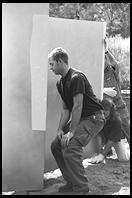 The viewfinder displays about 92 percent of the image plus an LCD display on the
bottom. Eyeglass wearers may have a tough time seeing to the corners of the
frame, especially if looking at the readouts. This may lead to overly centralized
image compositions. Even with a slow wide-angle zoom, it is easy to focus
manually on the ground glass. A built-in slider offers diopter adjustments from
-1.8 to +0.8. If you have a fantastic memory for trivia you might be able to
recall the custom function number that will turn on composition-aid grid lines in
the viewfinder.
The viewfinder displays about 92 percent of the image plus an LCD display on the
bottom. Eyeglass wearers may have a tough time seeing to the corners of the
frame, especially if looking at the readouts. This may lead to overly centralized
image compositions. Even with a slow wide-angle zoom, it is easy to focus
manually on the ground glass. A built-in slider offers diopter adjustments from
-1.8 to +0.8. If you have a fantastic memory for trivia you might be able to
recall the custom function number that will turn on composition-aid grid lines in
the viewfinder.
Exposure on the N80 is controlled with two wheels. One falls under your right index finger, just in front of the shutter release. The second is on the upper-right-hand corner of the back of the camera. You can operate it with your thumb scrunched up a bit. In manual exposure mode, the finger (front) button controls aperture, the thumb (rear) button controls shutter speed. In aperture-priority mode, the finger button controls aperture; the thumb button does nothing. In shutter-priority mode, the thumb button controls shutter speed; the finger button does nothing. In program-autoexposure mode, in which the camera picks both shutter speed and aperture, the finger button does nothing and the thumb button shifts the program, e.g., to be biased to use a substantially slower shutter speed because you know that the camera is on a tripod and the camera's computer isn't smart enough to know. The is one of the glories of the Nikon system compared to Canon. Instead of the camera forgetting your program shift for the next picture, it does into "P*" mode. Your bias is remembered until the camera is turned off or switched out of program mode.
Exposure compensation, by contrast, is handled clumsily. On a Canon EOS body you set exposure compensation by turning a convenient thumb wheel. The viewfinder display then shows graphically exactly how much compensation has been set. On the N80 you press a tiny little "+/-" button while simultaneously turning the thumb wheel. This is a bit awkward. What's worse, however, is that to see how much compensation has been set you have to press the tiny little button again. Exposure compensation persists even if the body has been turned entirely off and then on again.
The spot on a Canon EOS body that is given over to the 2nd exposure wheel is here on the N80 devoted to a four-way paddle. This is roughly in the middle of the camera back and is the easiest to reach spot for one's thumb, no scrunching. Nikon's paddle enables you to quickly change AF sensor. Personally I very seldom wish to change the AF sensor but am always toying with exposure or exposure compensation and therefore I prefer the Canon layout.
Depth of field preview is accomplished via a small button, perfectly placed on the center right of the lens mount.
The camera does not have "portrait, sports, landscape, etc." idiot modes like its mid-range Canon counterparts.
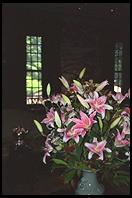 The N80 has excellent compatibility with
all previous Nikon AF-system flashes. The built-in flash has a guide number of 39
and a fixed coverage angle of 28mm, i.e., because the flash cannot zoom you're
wasting most of your flash power if you use it with a 50 or 85mm lens. The flash
pops up at the press of a small button on its left side.
The N80 has excellent compatibility with
all previous Nikon AF-system flashes. The built-in flash has a guide number of 39
and a fixed coverage angle of 28mm, i.e., because the flash cannot zoom you're
wasting most of your flash power if you use it with a 50 or 85mm lens. The flash
pops up at the press of a small button on its left side.
Maximum sync speed with a standard flash is 1/125th of a second.
The brilliant Nikon D flash exposure system ensures that whatever you focussed on is correctedly exposed. For example, in the image below the lens was focussed on the flowers. A standard through-the-lens (TTL) flash exposure system would try to keep dumping out power until the whole frame was nicely illuminated. Since the flowers occupy only a small portion of the frame they'd be blasted white. Nikon is smart enough to compute the appropriate flash duration from subject distance (read from lens) film speed, and aperture:
(Yes it is a terrible picture, like most taken with on-camera flash, but it illustrates a point.)
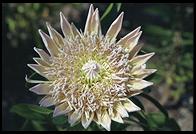 Probably the most desirable version of this camera is the "F80-S". This is
grey-market only. It imprints data in between film frames. You won't run the risk
of your images being ruined by a huge in-frame set of numbers. Yet if you are
willing to pull the negs out of the filing cabinet you can find out what f-stop
and shutter speed you were using. Avoid the US-market "Date" version of this
camera. This simply prints data inside the frame.
Probably the most desirable version of this camera is the "F80-S". This is
grey-market only. It imprints data in between film frames. You won't run the risk
of your images being ruined by a huge in-frame set of numbers. Yet if you are
willing to pull the negs out of the filing cabinet you can find out what f-stop
and shutter speed you were using. Avoid the US-market "Date" version of this
camera. This simply prints data inside the frame.
Do not get the N80 as part of a kit with a cheap zoom lens, Nikon or otherwise. The Nikon 50/1.8 is a great starter lens, rated by optical experts as one of the best 50mm lenses ever designed. The best user experience is provided by Nikon AF-S ("Silent Wave") lenses and Sigma HSM lenses. These include motors similar in principle to those in the extensive Canon EOS Ultrasonic line. Unfortunately, though both AF-S and HSM date back to 1998 or so, very few lenses are actually available.
The pair of CR123 lithium batteries in the body should last for 30 rolls or so, with some use of flash. If that isn't enough or if you expect to be traveling to remote regions where only AA batteries are available, consider the MB-16 grip. This lacks a vertical shutter release but it may make camera handling easier for those with large hands.
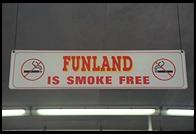 The latest round of camera reviews has forced me
to switch bodies every month or two. All of these bodies, including the modern
plastic ones, are usable in some sense without reference to the owner's manual.
However you can't get the full value out of a modern wonder unless you have a
prodigious memory or the manual in your pocket. For example, Nikon proudly
proclaims that the N80 has 18 customer functions. How much good will these do
you? If you can remember the meanings of "5-0", "5-1", and "5-2", quite a lot of
good.
The latest round of camera reviews has forced me
to switch bodies every month or two. All of these bodies, including the modern
plastic ones, are usable in some sense without reference to the owner's manual.
However you can't get the full value out of a modern wonder unless you have a
prodigious memory or the manual in your pocket. For example, Nikon proudly
proclaims that the N80 has 18 customer functions. How much good will these do
you? If you can remember the meanings of "5-0", "5-1", and "5-2", quite a lot of
good.
Consider a Leica M camera. You buy it. You read the owner's manual. For the rest of your life you can use the camera's three controls (focus, aperture, shutter speed) and two readouts (frame counter and exposure LEDs). You will never have to read the owner's manual again.
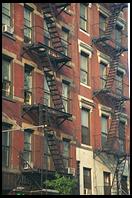 Let's go back to the
custom function idea. This was introduced by Canon in the late 1980s as part of
their EOS-1 body. The EOS-1 was Canon's top-of-the-line body and intended for
daily use by photojournalists. There weren't that many custom functions. The
photojournalist could be expected to carry a reminder card listing them all. The
photojournalist could be expected to remember from one day to the next what CF5
was for. Does it make sense to pull a feature from a working photojournalist's
daily tool and uncritically stuff it into a consumer's weekend or vacation
camera?
Let's go back to the
custom function idea. This was introduced by Canon in the late 1980s as part of
their EOS-1 body. The EOS-1 was Canon's top-of-the-line body and intended for
daily use by photojournalists. There weren't that many custom functions. The
photojournalist could be expected to carry a reminder card listing them all. The
photojournalist could be expected to remember from one day to the next what CF5
was for. Does it make sense to pull a feature from a working photojournalist's
daily tool and uncritically stuff it into a consumer's weekend or vacation
camera?
What could Nikon and Canon be doing? For one thing, the custom functions could be indicated by mnemonics, e.g., "gl" for grid lines. Instead of "0" and "1", how about "on" and "off"? This drives up the cost of the top-deck LCD display but it seems worth it (see the Minolta Maxxum 7, for example, which has a big plain-language display on the back). Or if these companies are truly determined to freeze photographers into the late 1980s Canon EOS-1 user interface, how about putting owner's manuals on the Web? Mamiya and Minolta have managed to do it. Virtually ever other camera manufacturer seems to be stuck in the "brochureware uber alles" theory of Web site design and determined to offer nothing to existing customers.
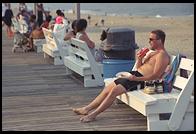 Nikon sells several more expensive bodies than
the N80. Given that the N80 is so capable, why would anyone want to burden
themselves with extra expense and weight?
Nikon sells several more expensive bodies than
the N80. Given that the N80 is so capable, why would anyone want to burden
themselves with extra expense and weight?
Room for improvement 1: viewfinders. The F100 viewfinder shows 96 percent of the image and is easy for eyeglass wearers. The F5 shows 100 percent of the image to be captured. This is ideal for those who will be scanning and presenting their work digitally. The F5 also has a tremendous amount of eye relief for eyeglass wearers and big-nosed photographers.
Room for improvement 2: water sealing. The bigger Nikon bodies are sealed against inclement weather. The N80 tested for this review was subjected to some rain drops and suffered no ill effects but it is not intended for use in downpours.
Room for improvement 3: vertical grip. With the F4 body, released in the late 1980s, Nikon was a pioneer in making camera handling neutral. The F4 has an integrated vertical grip and second shutter release. Your right index finger is always on top of the shutter release, regardless of whether you are holding the camera vertically or horizontally. The F5 continues this tradition with a built-in grip and extra shutter release. The F100 offers an optional MB-15 grip with secondary controls. The N80's battery pack MB-16 does not have a shutter release, much less a control wheel. This makes it inferior in this regard to the Canon Rebel. If you do a lot of portrait photography, you may wish to consider the F100, a used N90 with grip, or one of the low-end Canon bodies.
Room for improvement 4: mirror lock-up. If you're using lenses longer than 300mm or doing macro photography, you'll get higher quality images with a body that can lock its mirror up well before the exposure is made. This reduces vibration of the camera/lens/tripod system.
In the two weeks during which I tested the N80, I stumbled upon an installation of a sculpture entitled "Escaping Flatland". This was designed by information design authority Edward Tufte. As this was a photojournalism project, the N80 was loaded up with classic Kodak Tri-X.
(If you want one of these sculptures for your own backyard, you can order one at www.edwardtufte.com.)
We tested this camera with the 24-120 Nikon lens, a good choice for travel photography, especially if supplemented with a 50/1.8.
| 24mm | 120mm |
|---|---|
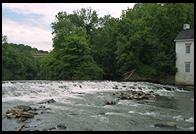
|
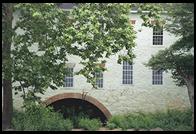
|
Here are a few snapshots from the Wilmington, Delaware area. Almost everything worth seeing in Wilmington stems from the immigration of the du Pont family from France around 1800. They came with utopian dreams but settled down to making gunpowder. The modern du Pont corporation was built by Pierre S. du Pont (1870-1954). He was an MIT-educated engineer. For five years, Pierre du Pont was simultaneously president of DuPont Corporation and General Motors Corporation. He was America's hardest core gardener and created Longwood Gardens.
Charm City (Baltimore, Maryland) has some nice buildings on the Inner Harbor plus a good public aquarium (notice how the last picture demonstrates that 120mm is too short even for captive wildlife; it is also another triumph for Nikon D flash metering):
If you're sick of the gentility and snobbery of Cape Cod, Martha's Vineyard, and Nantucket, the mid-atlantic coast is for you. There are boardwalks at Atlantic City, Rehoboth Beach, Bethany Beach (small), and Ocean City.
Text and pictures Copyright 2001 Philip Greenspun.